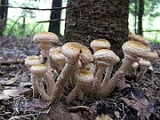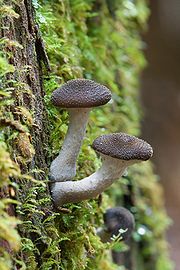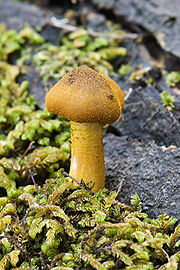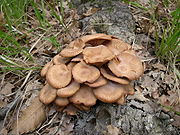
List of Armillaria species
Encyclopedia
Armillaria is a genus
of fungi commonly known as honey mushrooms. First treated by Elias Magnus Fries
in 1821, and later assigned generic rank by Friedrich Staude in 1857, Armillaria is classified in the Physalacriaceae
family of the Agaricales
, the gilled mushrooms. The majority of species in Armillaria are saprobic and live mainly on dead wood, but some are parasites which can cause root
and butt rot
in over 600 species of woody plants. Some Armillaria species form mycorrhizae with orchids
; others, such as A. gallica
, A. mellea
, and A. tabescens
, are bioluminescent
.
Armillaria species form fleshy, white-spore
d mushrooms with a cottony or membranous veil
that typically forms a distinct annulus
on the stem
. The fruit bodies
usually occur in autumn in large clusters at the base of the stem or roots. Armillaria species can produce rhizomorphs—rootlike aggregations of hypha
e—that can form massive, long-lasting underground networks. The growth of the rhizomorph networks allows for tree-to-tree spread of the fungus even when direct contact between diseased and healthy plants is not possible.
The genus once served as a wastebasket taxon for many agaric
mushrooms with a white spore print
, gills attached to the stem, and an annulus. Due largely to differing interpretations on the limits of the genus, over 270 species and varieties have been placed in Armillaria or its synonym Armillariella. A comprehensive 1995 study by Tom Volk and Harold Burdsall evaluated all of the epithets that have been used in Armillaria or Armillariella; they determined that about 40 species belong to Armillaria sensu stricto (in the strict sense); the remaining names belong to species that are distributed among 43 other modern fungal genera.
Many species
are difficult or impossible to distinguish from each other using observable characteristics; laboratory incompatibility
tests are often used on pure cultures to reliably determine species. Because of the difficulties posed by routine species identification, the use of DNA sequencing
and phylogenetic
approaches has become a standard method to help clarify relationships between species. Species differ in their geographical distribution and ecological position, host
specificity, microscopic and macroscopic features, and also in their aggressiveness in colonizing wood hosts. The following list of Armillaria species is based on the taxonomic
overviews provided by Volk and Burdsall in 1995, David Pegler in 2000, and reports of new species that have been published since then.





Genus
In biology, a genus is a low-level taxonomic rank used in the biological classification of living and fossil organisms, which is an example of definition by genus and differentia...
of fungi commonly known as honey mushrooms. First treated by Elias Magnus Fries
Elias Magnus Fries
-External links:*, Authors of fungal names, Mushroom, the Journal of Wild Mushrooming.*...
in 1821, and later assigned generic rank by Friedrich Staude in 1857, Armillaria is classified in the Physalacriaceae
Physalacriaceae
Physalacriaceae are a family of fungi in the order Agaricales. Species in the genus have a widespread distribution, but most are found in the tropics, particularly in South-East Asia and Australasia. Molecular studies suggested that Physalacria, formerly the sole genus in this family, is related to...
family of the Agaricales
Agaricales
The fungal order Agaricales, also known as gilled mushrooms , or euagarics, contains some of the most familiar types of mushrooms. The order has 33 extant families, 413 genera, and over 13000 described species, along with five extinct genera known only from the fossil record...
, the gilled mushrooms. The majority of species in Armillaria are saprobic and live mainly on dead wood, but some are parasites which can cause root
Root rot
Root rot is a condition found in both indoor and outdoor plants, although more common in indoor plants with poor drainage. As the name states, the roots of the plant rot. Usually, this is a result of overwatering. In houseplants, it is a very common problem, and is slightly less common in outdoor...
and butt rot
Butt rot
thumb|Butt rot of palm, caused by [[Ganoderma zonatum]]Butt rot is a disease of plants, mostly trees, caused by fungi. The fungus attacks the moist, poorly protected undersurface of tree trunk's thickest part , where the end of the stem makes contact with the soil. It may affect the roots as...
in over 600 species of woody plants. Some Armillaria species form mycorrhizae with orchids
Orchid mycorrhiza
Orchid mycorrhizae are symbiotic relationships between the roots of plants of the family Orchidaceae and a variety of fungi. All orchids are myco-heterotrophic at some point in their life cycle. Orchid mycorrhizae are critically important during orchid germination, as orchid seed has virtually no...
; others, such as A. gallica
Armillaria gallica
Armillaria gallica is a species of honey mushroom in the Physalacriaceae family of the Agaricales order. The species is a common and ecologically important wood-decay fungus that can live as a saprobe, or as an opportunistic parasite in weakened tree hosts to cause root or butt rot...
, A. mellea
Armillaria mellea
Armillaria mellea is a plant pathogen and a species of Honey fungus. It causes Armillaria root rot in many plant species. The mushrooms are edible but some people may be intolerant to them. The fungus produces mushrooms around the base of trees it has infected...
, and A. tabescens
Armillaria tabescens
Armillaria tabescens is a species of fungus in the Physalacriaceae family of mushroom. It is a plant pathogen.- External links :* *...
, are bioluminescent
Bioluminescence
Bioluminescence is the production and emission of light by a living organism. Its name is a hybrid word, originating from the Greek bios for "living" and the Latin lumen "light". Bioluminescence is a naturally occurring form of chemiluminescence where energy is released by a chemical reaction in...
.
Armillaria species form fleshy, white-spore
Spore
In biology, a spore is a reproductive structure that is adapted for dispersal and surviving for extended periods of time in unfavorable conditions. Spores form part of the life cycles of many bacteria, plants, algae, fungi and some protozoa. According to scientist Dr...
d mushrooms with a cottony or membranous veil
Partial veil
thumb|150px|right|Developmental stages of [[Agaricus campestris]] showing the role and evolution of a partial veilPartial veil is a mycological term used to describe a temporary structure of tissue found on the fruiting bodies of some basidiomycete fungi, typically agarics...
that typically forms a distinct annulus
Annulus (mycology)
An annulus is the ring like structure sometimes found on the stipe of some species of mushrooms. The annulus represents the remaining part of the partial veil, after it has ruptured to expose the gills or other spore-producing surface. An annulus may be thick and membranous, or it may be cobweb-like...
on the stem
Stipe (mycology)
thumb|150px|right|Diagram of a [[basidiomycete]] stipe with an [[annulus |annulus]] and [[volva |volva]]In mycology a stipe refers to the stem or stalk-like feature supporting the cap of a mushroom. Like all tissues of the mushroom other than the hymenium, the stipe is composed of sterile hyphal...
. The fruit bodies
Basidiocarp
In fungi, a basidiocarp, basidiome or basidioma , is the sporocarp of a basidiomycete, the multicellular structure on which the spore-producing hymenium is borne. Basidiocarps are characteristic of the hymenomycetes; rusts and smuts do not produce such structures...
usually occur in autumn in large clusters at the base of the stem or roots. Armillaria species can produce rhizomorphs—rootlike aggregations of hypha
Hypha
A hypha is a long, branching filamentous structure of a fungus, and also of unrelated Actinobacteria. In most fungi, hyphae are the main mode of vegetative growth, and are collectively called a mycelium; yeasts are unicellular fungi that do not grow as hyphae.-Structure:A hypha consists of one or...
e—that can form massive, long-lasting underground networks. The growth of the rhizomorph networks allows for tree-to-tree spread of the fungus even when direct contact between diseased and healthy plants is not possible.
The genus once served as a wastebasket taxon for many agaric
Agaric
An agaric is a type of fungal fruiting body characterized by the presence of a pileus that is clearly differentiated from the stipe , with lamellae on the underside of the pileus. "Agaric" can also refer to a basidiomycete species characterized by an agaric-type fruiting body...
mushrooms with a white spore print
Spore print
thumb|300px|right|Making a spore print of the mushroom Volvariella volvacea shown in composite: mushroom cap laid on white and dark paper; cap removed after 24 hours showing pinkish-tan spore print...
, gills attached to the stem, and an annulus. Due largely to differing interpretations on the limits of the genus, over 270 species and varieties have been placed in Armillaria or its synonym Armillariella. A comprehensive 1995 study by Tom Volk and Harold Burdsall evaluated all of the epithets that have been used in Armillaria or Armillariella; they determined that about 40 species belong to Armillaria sensu stricto (in the strict sense); the remaining names belong to species that are distributed among 43 other modern fungal genera.
Many species
Species
In biology, a species is one of the basic units of biological classification and a taxonomic rank. A species is often defined as a group of organisms capable of interbreeding and producing fertile offspring. While in many cases this definition is adequate, more precise or differing measures are...
are difficult or impossible to distinguish from each other using observable characteristics; laboratory incompatibility
Mating in fungi
Mating in fungi is a complex process governed by mating types. Research on fungal mating has focused on only a few model species. Since not all of the fungi reproduce sexually and many that do are isogamous, the terms male and female do not apply to this kingdom...
tests are often used on pure cultures to reliably determine species. Because of the difficulties posed by routine species identification, the use of DNA sequencing
DNA sequencing
DNA sequencing includes several methods and technologies that are used for determining the order of the nucleotide bases—adenine, guanine, cytosine, and thymine—in a molecule of DNA....
and phylogenetic
Phylogenetics
In biology, phylogenetics is the study of evolutionary relatedness among groups of organisms , which is discovered through molecular sequencing data and morphological data matrices...
approaches has become a standard method to help clarify relationships between species. Species differ in their geographical distribution and ecological position, host
Host (biology)
In biology, a host is an organism that harbors a parasite, or a mutual or commensal symbiont, typically providing nourishment and shelter. In botany, a host plant is one that supplies food resources and substrate for certain insects or other fauna...
specificity, microscopic and macroscopic features, and also in their aggressiveness in colonizing wood hosts. The following list of Armillaria species is based on the taxonomic
Taxonomy
Taxonomy is the science of identifying and naming species, and arranging them into a classification. The field of taxonomy, sometimes referred to as "biological taxonomy", revolves around the description and use of taxonomic units, known as taxa...
overviews provided by Volk and Burdsall in 1995, David Pegler in 2000, and reports of new species that have been published since then.
Key
| Name | The binomial name of the Armillaria species. |
|---|---|
| Authority | The author citation Author citation (botany) In botanical nomenclature, author citation refers to citing the person who validly published a botanical name, i.e. who first published the name while fulfilling the formal requirements as specified by the International Code of Botanical Nomenclature... —the person who first described Species description A species description or type description is a formal description of a newly discovered species, usually in the form of a scientific paper. Its purpose is to give a clear description of a new species of organism and explain how it differs from species which have been described previously, or are... the species using an available scientific name, eventually combined with the one who placed it in Armillaria, and using standardized abbreviations. |
| Year | The year in which the species was named, or transferred to the genus Armillaria. Where the actual year of publication (as defined for the purpose of priority Principle of Priority thumb|270px|Boa manditraIn zoology, the scientific study of animals, the Principle of Priority is one of the guiding principles of the International Code of Zoological Nomenclature, defined by Article 23.... ) differs from the date given in the material, the latter date is given in quotes. |
| Distribution | The distribution of the species; unless otherwise indicated, this information is obtained from Volk and Burdsall (1995), and Pegler (2000). |
Species





| Name | Authority | Year | Distribution |
|---|---|---|---|
| Armillaria affinis Armillaria affinis Armillaria affinis is a species of mushroom in the Physalacriaceae family. This species is found in Central America.... |
1995 | ||
| Armillaria apalosclera | 1982 ("1981") |
Asia | |
| Armillaria borealis Armillaria borealis Armillaria borealis is a species of mushroom in the Physalacriaceae family. Phylogenetic analysis of ribosomal DNA has shown that within the genus Armillaria, this species is most closely related to A. solidipes and A. gemina.... |
Marxm. & Korhonen | 1982 | Eurasia |
| Armillaria calvescens Armillaria calvescens Armillaria calvescens is a species of mushroom in the Physalacriaceae family. Similar in appearance to Armillaria gallica, this species is often found on maple in Canada and New England, as well as other hardwoods in the western United States.... |
Bérubé & Dessur. | 1989 | Eastern North America |
| Armillaria camerunensis Armillaria camerunensis Armillaria camerunensis is a species of mushroom in the Physalacriaceae family. This species is found in Africa.... |
1995 | Africa | |
| Armillaria cepistipes Armillaria cepistipes Armillaria cepistipes is a species of mushroom in the Physalacriaceae family. This is a weakly plant pathogenic species that is typically found growing at the base of deciduous trees that have previously been stressed by another pathogen.... |
Velen. | 1920 | |
| Armillaria duplicata Armillaria duplicata Armillaria duplicata is a species of mushroom in the Physalacriaceae family. This species is found in Asia.... |
1887 | India | |
| Armillaria ectypa Armillaria ectypa Armillaria ectypa is a species of mushroom in the Physalacriaceae family. Commonly known as the Marsh Honey Fungus, it prefers growing in sphagnum bogs with mosses. It is classified as endangered in Great Britain, and is protected under the Wildlife and Countryside Act of 1981; it is also on the... |
1965 | Europe | |
| Armillaria fellea Armillaria fellea Armillaria fellea is a species of mushroom in the Physalacriaceae family. This species is found in Australia.... |
1983 | Australia | |
| Armillaria fumosa Armillaria fumosa Armillaria fumosa is a species of mushroom in the Physalacriaceae family. This species is found in Australia.... |
Kile & Watling | 1983 | Australia |
| Armillaria fuscipes Armillaria fuscipes Armillaria fuscipes is a plant pathogen that causes Armillaria root rot on Pinus, coffee plants, tea and various hardwood trees. It is common in South Africa.- External links :* *... |
Petch | 1909 | |
| Armillaria gallica Armillaria gallica Armillaria gallica is a species of honey mushroom in the Physalacriaceae family of the Agaricales order. The species is a common and ecologically important wood-decay fungus that can live as a saprobe, or as an opportunistic parasite in weakened tree hosts to cause root or butt rot... |
Marxm. & Romagn. Henri Romagnesi Henri Charles Louis Romagnesi was a French mycologist who was notable for a thorough review and monograph of the agaric genus Entoloma , as well as extensive work on the large genus Russula, of which he described several new species.-References:... |
1987 | |
| Armillaria gemina Armillaria gemina Armillaria gemina is a species of mushroom in the Physalacriaceae family. In North America, this rare species is found from the Appalachian Mountains eastwards.... |
Bérubé & Dessur. | 1989 | Eastern North America |
| Armillaria griseomellea Armillaria griseomellea Armillaria griseomellea is a species of mushroom in the Physalacriaceae family. This species is found in South America.... |
1983 | North and South America | |
| Armillaria heimii Armillaria heimii Armillaria heimii is a species of fungus in the Physalacriaceae family of mushrooms.- External links :* *... |
Pegler | 1977 | Africa |
| Armillaria hinnulea Armillaria hinnulea Armillaria hinnulea is a species of mushroom in the Physalacriaceae family. This rare species is found only in Australia and New Zealand; in Australia, it is a secondary pathogen of wet sclerophyll forests, and causes a woody root rot. A 2008 phylogenetic study of Australian and New Zealand... |
Kile & Watling | 1983 | Australasia |
| Armillaria jezoensis Armillaria jezoensis Armillaria jezoensis is a species of mushroom in the Physalacriaceae family. Found in Japan, it was described as new to science in 1994.... |
J.Y.Cha & Igarashi | 1994 | Japan |
| Armillaria limonea Armillaria limonea Armillaria limonea is a species of mushroom in the Physalacriaceae family. This plant pathogenic species is one of three Armillaria that have been identified in New Zealand .... |
1977 | ||
| Armillaria luteobubalina Armillaria luteobubalina Armillaria luteobubalina, commonly known as the Australian honey fungus, is a species of mushroom in the family Physalacriaceae. Widely distributed in southern Australia, the fungus is responsible for a disease known as Armillaria root rot, a primary cause of Eucalyptus tree death and forest dieback... |
Watling & Kile | 1978 | |
| Armillaria mellea Armillaria mellea Armillaria mellea is a plant pathogen and a species of Honey fungus. It causes Armillaria root rot in many plant species. The mushrooms are edible but some people may be intolerant to them. The fungus produces mushrooms around the base of trees it has infected... |
1871 | ||
| Armillaria melleorubens Armillaria melleorubens Armillaria melleorubens is a species of mushroom in the Physalacriaceae family. This species is found in Central America.... |
1887 | North and Central America | |
| Armillaria montagnei Armillaria montagnei Armillaria montagnei is a species of mushroom in the Physalacriaceae family. This species is found in Australia, Europe, New Zealand, and South America.... |
1973 | ||
| Armillaria nabsnona Armillaria nabsnona Armillaria nabsnona is a species of fungus in the Physalacriaceae family. The species is distributed in North America and Japan.... |
T.J.Volk & Burds. | 1996 | |
| Armillaria novae-zelandiae Armillaria novae-zelandiae Armillaria novae-zelandiae is a species of mushroom in the Physalacriaceae family. This plant pathogen species is one of three Armillaria species that have been identified in New Zealand .... |
1973 | ||
| Armillaria omnituens Armillaria omnituens Armillaria omnituens is a species of mushroom in the Physalacriaceae family. This species is found in Asia.... |
1887 | India | |
| Armillaria pallidula Armillaria pallidula Armillaria pallidula is a species of mushroom in the Physalacriaceae family. This species is found in Australia.... |
Kile & Watling | 1988 | Australia |
| Armillaria paulensis Armillaria paulensis Armillaria paulensis is a species of mushroom in the Physalacriaceae family. This species is found in South America.... |
Capelari | 2008 | South America |
| Armillaria pelliculata Armillaria pelliculata Armillaria pelliculata is a species of mushroom in the Physalacriaceae family. This species is found in Africa.... |
Beeli Maurice Beeli Maurice Beeli was a Belgian mycologist. A collaborator of the National Botanic Garden of Belgium, he kickstarted interest from Belgian scientist in tropical macromycetes and initiated work on the Flore iconographique des champignons du Congo, precursor to the Flore illustrée des champignons... |
1927 | Africa |
| Armillaria procera Armillaria procera Armillaria procera is a species of mushroom in the Physalacriaceae family. This species is found in South America.... |
Speg. | 1889 | South America |
| Armillaria puiggarii Armillaria puiggarii Armillaria puiggarii is a species of mushroom in the Physalacriaceae family. This species is found in Central and South America.... |
Speg. | 1889 | South America |
| Armillaria sinapina Armillaria sinapina Armillaria sinapina is a species of mushroom in the Physalacriaceae family. A plant pathogenic fungus, it causes Armillaria root disease, and has been found on a variety of tree hosts in Alaska.... |
Bérubé & Dessur. | 1988 | |
| Armillaria singula Armillaria singula Armillaria singula is a species of mushroom in the Physalacriaceae family. This species is found in Asia.... |
J.Y.Cha & Igarashi | 1994 | |
| Armillaria socialis Armillaria socialis Armillaria socialis is a species of fungus in the Physalacriaceae family. It is a plant pathogen. Originally described by Augustin Pyramus de Candolle in 1815, it was transferred to Armillaria by Victor Fayod in 1889. It is found in Asia, Europe, and North America.... |
1889 | ||
| Armillaria solidipes | Peck Charles Horton Peck Charles Horton Peck, born March 30, 1833 in Sand Lake, New York, died 1917 in Albany, New York, was an American mycologist of the 19th and early 20th centuries... |
1900 | |
| Armillaria sparrei Armillaria sparrei Armillaria sparrei is a species of mushroom in the Physalacriaceae family.... |
1973 | North and South America | |
| Armillaria tabescens Armillaria tabescens Armillaria tabescens is a species of fungus in the Physalacriaceae family of mushroom. It is a plant pathogen.- External links :* *... |
1921 | ||
| Armillaria tigrensis Armillaria tigrensis Armillaria tigrensis is a species of mushroom in the Physalacriaceae family. This species is found in South America.... |
1983 | South America | |
| Armillaria umbrinobrunnea Armillaria umbrinobrunnea Armillaria umbrinobrunnea is a species of mushroom in the Physalacriaceae family. This species is found in South America. The beige to light brown caps of the mushroom are between in diameter, and densely covered in small scales. The species was originally collected in 1952 by Rolf Singer in... |
2010 | South America | |
| Armillaria viridiflava Armillaria viridiflava Armillaria viridiflava is a species of mushroom in the Physalacriaceae family. This species is found in South America.... |
1995 | ||
| Armillaria yungensis Armillaria yungensis Armillaria yungensis is a species of mushroom in the Physalacriaceae family. This species is found in South America.... |
1973 | South America | |
| NABS X | — | — | North America |

